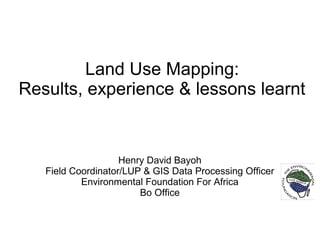
henry_jan_2014-final
- 1. Land Use Mapping: Results, experience & lessons learnt Henry David Bayoh Field Coordinator/LUP & GIS Data Processing Officer Environmental Foundation For Africa Bo Office
- 2. Objectives FoSED objectives: Develop participatroy land use plans in some communities. Ensure proper implementation The peoples objectives: Avoid conflict (land is an emotive subject) Maintain status quo (ie ensure current owners and users don't loose out or gain unfairly) Have evidence of their natural resource base
- 3. Approach: collaborative and iterative Collaborative – with the people, (by the people), for the people Iterative - Discussion with communities Field work with community guides Draft map (based on image interpretation) Discussion with communities (in groups) Field work with community representatives Training of community rep's in use of GPS and data collection Revision of map Validation and verification Periodic updates
- 4. Technology Location and attribute data (GPS - global positioning system), hand held device records geographic location; user records “attributes” (cover, use, ownership, condition etc etc) manual image interpretation (GoogleEarth) Cartography (map making and printing) (ArcMap)
- 5. Global Positioning System Four or five devices tested – more complex devices take longer to learn but are quicker in the field Need to use device regularly as knowledge decays quickly and they can be frustrating to use Need basic literacy skills but primary school education probably enough Have taught 16 community members how to use GPS; most (but not all) got to basic level in 1 day. (a further 8 in land use planning)
- 6. Image Interpretation Initial interpretation using GoogleEarth Advantages: Simple to learn (a few hours) Free Disadvantages: Limited capability (eg will not measure areas unless you pay for the “professional” version) Must be “on-line” (ie connected to the Internet) Cartography capability poor (i.e. Difficult to print nicely)
- 8. Village
- 9. School
- 10. Swamp – once improved now abandoned?
- 11. Inland valley swamps in matrix of farm bush
- 12. Trees, swamps, oil palm village
- 14. Small islands, trees, bamboo and rafia palm
- 16. Cartography and Printing ArcMap Advantages: Can do almost anything with spatial data Don't have to be connected to Internet Disadvantages: Stupidly expensive Mind-numbingly complex Most basic level users have specialist training at MSc level, plus daily use for 6 months or a year
- 17. Leasons Learnt - Technical Need recent high quality, high resolution images and these do not always exist Done properly (ie with and for the communities) the process is time consuming and therefore expensive. Mixed plantations and natural forests can be very difficult to distinguish Remains of swamp development (abandoned swamps) more visible from the air than the ground.
- 18. Image Quality
- 19. Clouds
- 20. Leasons Learnt - social Communities primarily interested in cadastral mapping (ie mapping ownership and boundaries) Teaching local people how to use GPS feasible and attractive Having different people do the field work and the office work is a very BAD idea Local people are able to interpet / use “conventional” maps People want the names of natural features (eg streams, swamps) to appear on the maps
- 21. Prospects Where recent, high quality, high resolution images are available the process can be carried out. Workshops have been held in many of these communities to discuss formal land use planning Communities encountered so far are positive about mapping and have their own ideas about what should constitute planning.
- 22. Thank you Henry David Bayoh EFA Office, Bo Tel: +232(0)76879222 “Everything can always be done better than it is.” …Henry Ford
